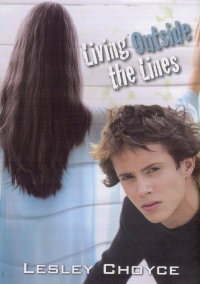| ________________
CM . . . . Volume XVI Number 25. . . .March 5, 2010.
excerpt:
Living Outside the Lines is an intriguing book with an interesting premise. Nigel Lukes, the main character, writes a novel about a utopian future in which adolescents are in charge and everyone retires when they turn 21. He is inspired by Michelle, a mysterious girl with whom he falls in love. His book catches the attention of radicals who use it�and Nigel�as a rallying point for their demands that the political system be changed to allow youth more power. Uncomfortable with his notoriety, Nigel retreats to Michelle�s cabin where he discovers that she is from the future. She tells him that his book will successfully inspire a peaceful revolution and that she lives in the utopia he envisioned. The bad news is that she has a terminal disease, and now she has to return to the future and die. Nigel decides to travel with her to the future, to stay with her as long as possible. He gets to see the future his book inspired, one in which most environmental and social problems have been solved, and, although not all diseases have been cured, everyone is much healthier and happier. Then he has to watch Michelle die and make the difficult decision to continue on without her. Nigel is a sympathetic narrator who begins the story as an outcast and then quite literally creates a world in which he can belong. His story has multi-layered complexity: we follow his love story with Michelle and his gradual discovery of her secret, along with the progress of his novel and its effect on his society; Choyce also gives us excerpts from Nigel�s novel, and so we follow the story of an adolescent beginning his career at age 15 in Nigel�s imagined future world. Then when Nigel travels to the future, we see the differences between what he imagined and what came to pass. The only thing we don�t see is how society manages to transform itself into this utopia. By sending Nigel into the future, Choyce neatly avoids having to explain the revolution except in the vaguest of terms. Sometimes Living Outside the Lines sounds less like a novel and more like a platform for Choyce to air opinions about topics like age discrimination and euthanasia. Dialogue between characters is sometimes in the form of short lectures, particularly in Nigel�s story: �We�re still being punished for the bad decisions from the past,� Tamara said. �Even back in the 1980�s, they knew they had made some monumentally bad decisions�and had allowed old ways to continue way too long. The climate changes were already happening. There was so little effort to make a difference.� But the characters have real emotions, and the plot is compelling. Only the ending falls short of being convincing. This novel will appeal to thoughtful readers and is sure to generate discussion in a classroom. Recommended. Kim Aippersbach, who lives in Vancouver, BC, is a free-lance editor and writer with three children.
To comment on this title or this review, send mail to cm@umanitoba.ca. Copyright © the Manitoba Library Association. Reproduction for personal use is permitted only if this copyright notice is maintained. Any other reproduction is prohibited without permission.
NEXT REVIEW | TABLE OF CONTENTS FOR THIS ISSUE- March 5, 2010. AUTHORS | TITLES | MEDIA REVIEWS | PROFILES | BACK ISSUES | SEARCH | CMARCHIVE | HOME |
